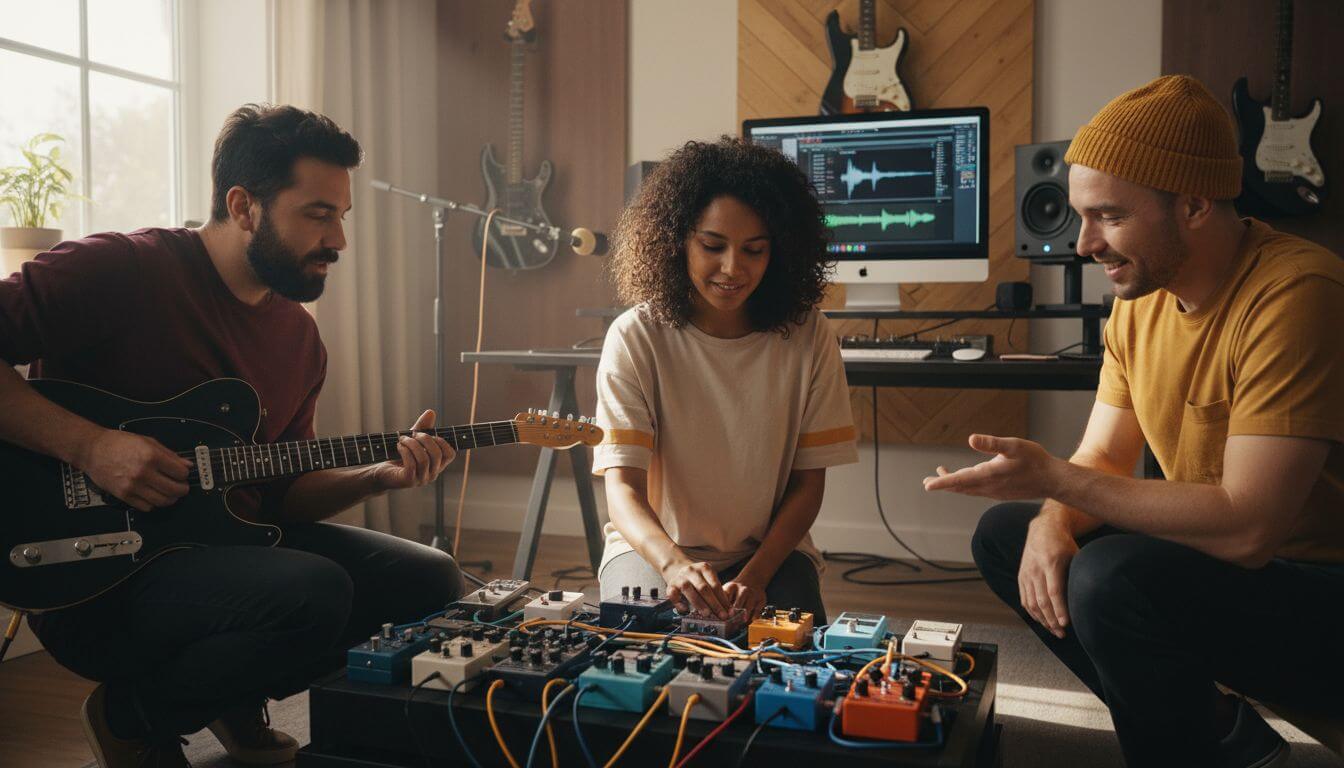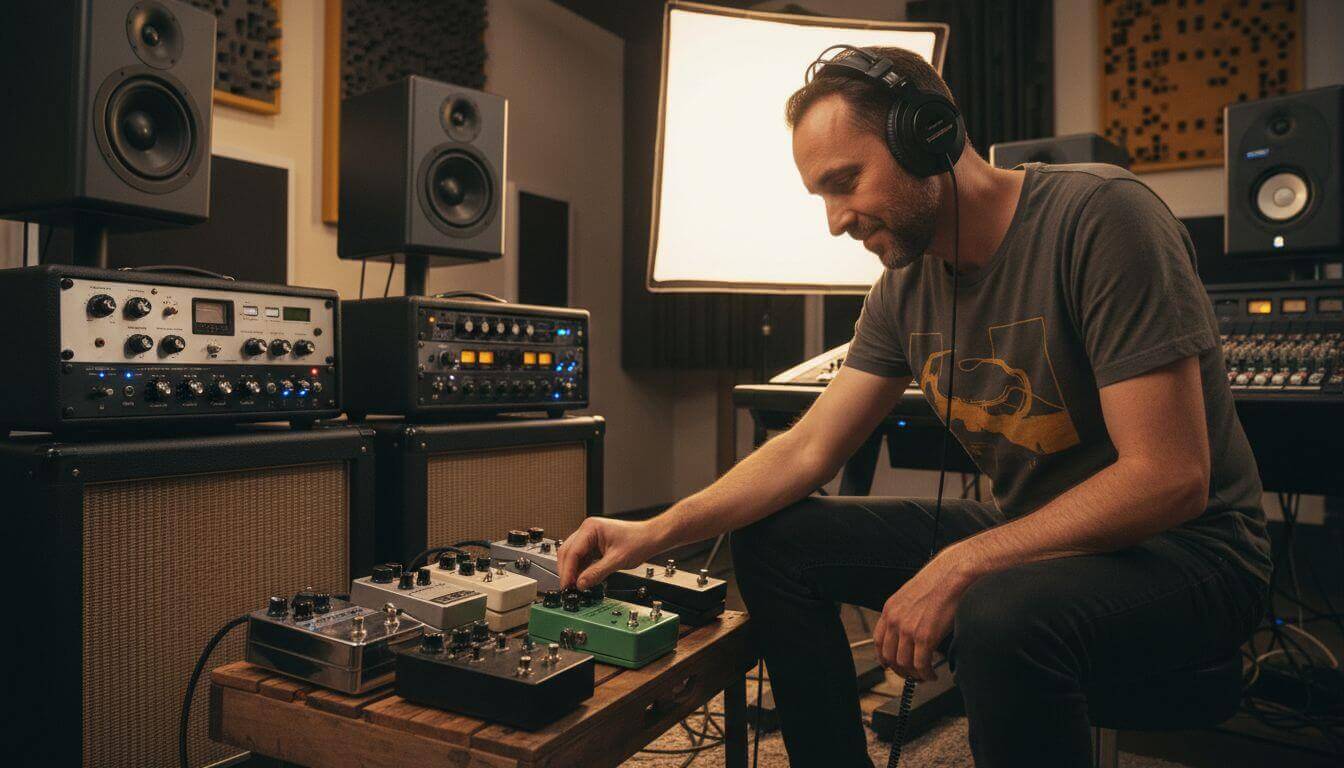Did you know that over 70 percent of guitarists use at least three pedals in their setup? These compact devices are essential for shaping your sound, offering countless ways to explore creativity and style. Whether you play at home or perform on stage, understanding guitar pedals can dramatically transform your music. Learning how to choose, arrange, and maintain your pedals helps you find your unique voice and avoid common mistakes that limit your sonic potential.
Table of Contents
- 1. Understand The Different Types Of Guitar Pedals
- 2. Arrange Pedals For Optimal Signal Chain Order
- 3. Power Your Pedals Safely And Efficiently
- 4. Dial In The Perfect Settings For Each Effect
- 5. Balance Clean And Distorted Sounds Effectively
- 6. Use Expression And Tap Tempo For Dynamic Play
- 7. Maintain And Troubleshoot Your Pedal Setup
Quick Summary
| Takeaway | Explanation |
|---|---|
| 1. Experiment with pedal types | Start with one type at a time to understand its nuances and how it interacts with your amplifier. |
| 2. Optimize your pedal order | Use the recommended pedal order to maintain signal integrity and clarity in your sound. |
| 3. Use isolated power supplies | Prevent noise and interference by matching voltage and using quality power supplies for each pedal. |
| 4. Master pedal controls | Learn the primary controls (level, drive, tone) to dial in your desired sound effectively. |
| 5. Regularly maintain your pedals | Clean connections and check cable integrity to prevent technical failures during performances. |
1. Understand the Different Types of Guitar Pedals
Navigating the world of electric guitar pedals can feel like exploring an intricate sonic landscape. Understanding the various types of pedals is crucial for crafting your unique sound and expanding your musical capabilities.
Guitar pedals fundamentally transform your instrument’s raw signal into something extraordinary, offering musicians an incredible palette of sound manipulation. From classic designs like the legendary Fuzz Face that debuted in 1966 to modern digital marvels, each pedal type serves a distinct purpose.
The primary categories of guitar pedals include:
- Distortion Pedals: Create gritty, aggressive tones by clipping the audio signal
- Overdrive Pedals: Simulate the warm, natural breakup of an overdriven tube amplifier
- Modulation Pedals: Alter sound waves to produce chorus, flanger, or phaser effects
- Time Based Pedals: Generate echo, delay, and reverb sounds
- Pitch Shifting Pedals: Change the fundamental pitch of your guitar signal
Professional guitarists often combine multiple pedals to create complex, layered sounds. For instance, the iconic Ibanez Tube Screamer has been a staple in rock music since 1979, providing a mid-boosted tone that cuts through dense musical arrangements.
To truly master guitar pedals, start by experimenting with one type at a time. Learn its nuances, understand how it interacts with your amplifier, and gradually build your pedal collection based on the sounds you want to achieve. Remember that pedal selection is deeply personal your tone is your musical signature.
2. Arrange Pedals for Optimal Signal Chain Order
The order of your guitar pedals can make or break your sound. Understanding the optimal signal chain sequence is crucial for achieving pristine tone and preventing unwanted sonic interference.
According to professional audio research, there is a recommended pedal arrangement that maximises your sound quality. The basics of pedalboards suggest following a strategic sequence that preserves signal integrity and tonal clarity.
The standard recommended pedal order is:
- Tuner: Always first to ensure accurate signal monitoring
- Dynamics Pedals: Compressors and volume pedals come next
- Filter Pedals: Wah and EQ pedals follow
- Gain Stages: Overdrive, distortion, and fuzz pedals
- Modulation Effects: Chorus, phaser, and flanger pedals
- Time Based Effects: Delay and reverb pedals last
This strategic arrangement ensures that each pedal receives a clean signal and processes it without unwanted interference. For instance, placing a noisy distortion pedal before a sensitive modulation effect can muddy your tone significantly.
Practical tip: Think of your signal chain like a sonic pathway. Each pedal should enhance rather than compete with the others. Experiment with your specific pedals and trust your ears your unique sound is what matters most.
3. Power Your Pedals Safely and Efficiently
Powering your guitar pedals might seem straightforward, but it is a critical aspect of maintaining excellent sound quality and preventing potential equipment damage. Understanding how to power your pedals correctly can make a significant difference in your overall musical performance.
Proper power supply management is fundamental to preserving your pedals and achieving pristine tone. When exploring essential effects for transforming your sound, choosing the right power solution becomes paramount.
Key considerations for powering guitar pedals include:
- Use isolated power supplies to prevent unwanted noise and interference
- Match voltage and current ratings precisely for each pedal
- Invest in high-quality power distribution units
- Avoid daisy chaining multiple pedals with different power requirements
- Consider dedicated power supplies for digital and analog pedals
Many guitarists underestimate the importance of clean power. Cheap or shared power supplies can introduce electrical noise that degrades your signal quality, creating unwanted hum or buzz in your sound.
A professional tip is to treat your pedal power supply like the foundation of a house. Just as a solid foundation supports a building, a robust power system supports your entire sonic ecosystem. Invest in quality power infrastructure and your tone will thank you.
4. Dial in the Perfect Settings for Each Effect
Mastering your guitar pedals is an art form that requires patience, experimentation, and a keen ear. Learning to dial in the perfect settings transforms good sound into extraordinary musical expression.
Understanding the fundamental controls of your pedals is crucial for achieving your desired tone. Take the classic overdrive guide as an example many pedals share similar control structures that allow nuanced sound manipulation.
Most pedals typically feature three primary controls:
- Level/Volume: Determines the output volume of the effect
- Drive/Gain: Controls the intensity of the effect
- Tone: Adjusts the treble and bass frequencies
For overdrive pedals like the Tube Screamer, subtle adjustments can dramatically alter your sound. Start with all controls at midpoint and make incremental changes. Boost the drive for more distortion, adjust tone to brighten or darken your sound, and use the level control to match your unaffected signal volume.
Pro tip: Always set your pedal settings in the context of your entire band mix. What sounds perfect solo might overwhelm other instruments. Trust your ears and be prepared to make real time adjustments during performance. Your tone is a living, breathing element of your musical expression.
5. Balance Clean and Distorted Sounds Effectively
Creating a seamless transition between clean and distorted sounds is an art form that separates good guitarists from great ones. Your ability to navigate between pristine clarity and raw intensity defines your musical expression.
Dynamic tone management requires strategic pedal positioning and thoughtful signal processing. When exploring essential pedals for transforming your sound, understanding how to balance different tonal characteristics becomes paramount.
Key strategies for balancing clean and distorted sounds include:
- Use overdrive pedals as a bridge between clean and distorted tones
- Set your amp with a baseline clean sound
- Adjust pedal gain to complement your amplifier’s natural character
- Practice smooth transitions between different sound levels
- Experiment with your guitar volume knob for dynamic control
Classic overdrive pedals like the Tube Screamer have long been musicians’ secret weapons for achieving nuanced tone transitions. By carefully adjusting your pedal settings, you can create a spectrum of sounds that range from pristine clean to full blown distortion.
Remember that your tone is a personal journey. What works for one guitarist might not work for another. Trust your ears, experiment relentlessly, and develop a sound that truly represents your musical personality.
6. Use Expression and Tap Tempo for Dynamic Play
Expression and tap tempo pedals transform your guitar playing from static to extraordinarily dynamic. These innovative tools allow musicians to add real time modulation and precise rhythmic control that breathes life into every performance.
Foot controlled pedals offer musicians unprecedented sonic manipulation. From the classic sound transforming techniques used in function bands, expression pedals like the wah provide incredible tonal flexibility.
Key techniques for using expression and tap tempo pedals include:
- Use expression pedals for real time tone sweeping
- Synchronise time based effects with band tempo
- Practice smooth heel to toe movements
- Experiment with different pedal sweep ranges
- Learn subtle modulation techniques
A wah pedal operates like a dynamic tone control connected to a potentiometer. By rocking the pedal with your foot, you can create vocal like sweeps that transform your guitar sound from thick and bassy to piercing and trebly.
Pro tip: Think of your expression pedal as an extension of your musical voice. The most interesting players treat their pedals like additional instruments rather than mere sound modifiers. Your feet can create as much musical expression as your hands.
7. Maintain and Troubleshoot Your Pedal Setup
A well maintained pedal setup is the backbone of consistent musical performance. Like any precision equipment, guitar pedals require regular care to ensure optimal sound quality and longevity.
Routine maintenance prevents unexpected technical failures during critical moments. If you want to keep your guitar and equipment in top condition, your pedal maintenance routine is absolutely crucial.
Essential maintenance and troubleshooting steps include:
- Clean pedal connections and input/output jacks regularly
- Check cable integrity and replace worn cables
- Test power supplies and connections periodically
- Store pedals in protective cases when not in use
- Keep pedals away from moisture and extreme temperatures
Common issues like signal loss, unexpected noise, or intermittent sound often stem from simple problems. A loose cable, dusty connection, or incorrect power supply can transform your pristine tone into a muddy mess.
Pro tip: Treat your pedal setup like a precision instrument. Perform a quick diagnostic check before every performance. Your future self on stage will thank you for the preventative maintenance.
Below is a comprehensive table summarising the main concepts, steps, and strategies for using guitar pedals effectively as discussed throughout the article.
| Topic | Description | Key Considerations |
|---|---|---|
| Understand Types of Pedals | Covers distortion, overdrive, modulation, time-based, and pitch-shifting pedals. | Experiment with each type to build your unique sound palette. |
| Optimal Signal Chain Order | Suggested sequence: Tuner, Dynamics, Filter, Gain Stages, Modulation, Time Based. | Ensures pristine tone by minimising interference. |
| Powering Pedals | Importance of proper power supply management to avoid noise. | Use isolated power supplies and match power ratings. |
| Dialing in Settings | Fundamental controls: Level, Drive, Tone. | Adjust settings within band mix context for best results. |
| Balancing Sounds | Strategies for transitioning between clean and distorted tones. | Use amp’s clean sound as a base, adjusting pedal gain. |
| Using Expression & Tap Tempo | Real-time modulation and rhythmic control tools. | Treat expression pedals as extensions of musical voice. |
| Maintenance & Troubleshooting | Regular care for optimal sound and functionality. | Clean connections, check cables, and store safely. |
Elevate Your Guitar Pedal Experience with MusicStreet
Struggling to master your guitar pedals and achieve that perfect tone can be frustrating. Whether you need expert advice on signal chain order or want to explore quality pedals that deliver pristine sound without noise, MusicStreet is here to help. Our carefully curated selection of pedals and accessories is designed to support your musical journey every step of the way—from powering your pedals safely to dialing in flawless settings.

Discover premium pedals, trusted power supplies, and essential tools at MusicStreet.co.uk and explore our dedicated resources to optimise your setup. Act now to transform your sound with confidence and craftsmanship. Visit MusicStreet today and experience personalised service both online and at our Huntingdon store. Your perfect tone awaits!
Frequently Asked Questions
How should I arrange my electric guitar pedals for the best sound?
To achieve optimal sound quality, arrange your pedals in a recommended order: begin with the tuner, followed by dynamics pedals, filter pedals, gain stages, modulation effects, and finally time-based effects. Experiment with this sequence to find the setup that best enhances your tone.
What are some essential maintenance tips for my electric guitar pedals?
Regularly clean pedal connections and input/output jacks to prevent dirt buildup that can affect performance. Additionally, check cable integrity and store pedals in protective cases to prolong their lifespan.
How can I dial in the perfect settings for my overdrive pedal?
Start with your overdrive pedal controls set at the midpoint and make small adjustments to the level, drive, and tone until you achieve your desired sound. For instance, boost the drive for more distortion, then fine-tune the tone to match your musical context.
What is the importance of using an expression pedal with my guitar setup?
An expression pedal allows you to control dynamics in real time, enabling you to create sweeping tones and modulations during performances. Incorporate this pedal by practicing smooth transitions between heel and toe movements to maximize your tonal flexibility.
How can I effectively balance clean and distorted sounds while playing?
Utilize overdrive pedals as a bridge between clean and distorted tones, adjusting your amp’s baseline clean sound and the pedal’s gain accordingly. Practice transitioning smoothly between different sound levels to create a cohesive play style.
What should I do if I encounter noise issues with my pedal setup?
First, check that you are using isolated power supplies to avoid unwanted noise interference. If issues persist, inspect cables and connections for damage, and consider replacing any worn or faulty components to maintain sound clarity.




Share:
What Is Overdrive? Complete Guide for Guitarists
What Is Fuzz? Complete Guitar Effect Overview